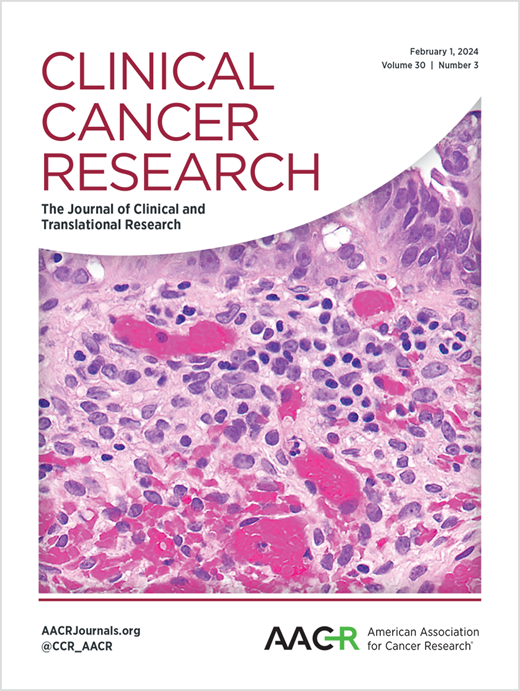每日依西美坦治疗子宫内膜上皮内瘤变或低级别子宫内膜癌的初步研究
IF 10.2
1区 医学
Q1 ONCOLOGY
引用次数: 0
摘要
目的:评价芳香化酶抑制剂依西美坦对子宫内膜癌的预防干预作用。方法:这是一项多中心、单臂、“机会之窗”的前期研究,在因子宫内膜上皮内瘤变(EIN)或低级别子宫内膜癌(EC)而接受子宫切除术的绝经后患者中使用依西美坦(每天25毫克,持续21-42天)。主要目的是通过Ki-67表达来确定治疗前后子宫内膜组织标本中增殖的变化。次要结果包括循环血清雌二醇和黄体酮水平、病理反应、组织生物标志物、安全性和不良反应的测量。结果:40名参与者累积到研究中。术前诊断包括EIN (n=11, 27.5%)、1级EC (n=26, 65%)和2级EC (n=3, 7.5%)。中位Ki-67评分从基线时的40.7% [IQR(33.9, 50.3)]降至手术时的18.1% [IQR(8.8, 31.8)],中位绝对变化为20.4% [IQR (-29.9, -6.7), p<0.001]。在匹配的历史对照队列中,参与者的Ki-67评分也下降,与基线相比的中位绝对变化为-6.7% [IQR (-12.7, -1.3), p 0.001]。然而,研究参与者的Ki-67下降幅度大于历史对照组,两组间的中位数差异为-13.4% [IQR (-23.3, 6.9), p]。依西美坦治疗后,组织ER和PR表达均显著下降(p < 0.01;lt;0.001)。然而,血清雌二醇水平在基线和治疗后没有变化(p=0.16)。结论:在这项初步研究中,依西美坦在子宫内膜上皮内瘤变和低级别子宫内膜癌中显示出抗增殖作用。该制剂在预防子宫内膜癌方面值得进一步评估。本文章由计算机程序翻译,如有差异,请以英文原文为准。
Pilot Study of Daily Exemestane in Women with Endometrial Intraepithelial Neoplasia or Low Grade Endometrial Cancer
Objective: To evaluate exemestane, an aromatase inhibitor, as a preventive intervention for endometrial cancer. Methods: This is a multi-center, single-arm, ‘window of opportunity’ pilot study of exemestane (25 mg daily for 21-42 days) in postmenopausal individuals undergoing hysterectomy for endometrial intraepithelial neoplasia (EIN) or low-grade endometrial cancer (EC). The primary objective is to determine change in proliferation, measured by Ki-67 expression, in pre- and post-treatment endometrial tissues specimens. Secondary outcomes include measurement of circulating serum estradiol and progesterone levels, pathologic response, tissue biomarkers, safety, and adverse effects. Results: Forty participants were accrued to the study. Preoperative diagnoses included EIN (n=11, 27.5%), grade 1 EC (n=26, 65%), and grade 2 EC (n=3, 7.5%). Median Ki-67 score decreased from 40.7% [IQR (33.9, 50.3)] at baseline to 18.1% [IQR (8.8, 31.8)] at surgery, representing a median absolute change of 20.4% [IQR (-29.9, -6.7), p<0.001]. In a matched historical control cohort, participants also had a decrease in Ki-67 score with a median absolute change from baseline of -6.7% [IQR (-12.7, -1.3), p 0.001]. However, the decrease in Ki-67 was greater in the study participants than the historic controls, with a median difference between the groups of -13.4% [IQR (-23.3, 6.9), p ]. Both tissue ER and PR expression declined significantly with exemestane treatment (p<0.001). However, serum estradiol levels did not change between baseline and post-treatment (p=0.16). Conclusion: In this pilot study, exemestane demonstrated anti-proliferative effects in endometrial intraepithelial neoplasia and low-grade endometrial cancer. This agent warrants further evaluation for the prevention of endometrial cancer.
求助全文
通过发布文献求助,成功后即可免费获取论文全文。
去求助
来源期刊

Clinical Cancer Research
医学-肿瘤学
CiteScore
20.10
自引率
1.70%
发文量
1207
审稿时长
2.1 months
期刊介绍:
Clinical Cancer Research is a journal focusing on groundbreaking research in cancer, specifically in the areas where the laboratory and the clinic intersect. Our primary interest lies in clinical trials that investigate novel treatments, accompanied by research on pharmacology, molecular alterations, and biomarkers that can predict response or resistance to these treatments. Furthermore, we prioritize laboratory and animal studies that explore new drugs and targeted agents with the potential to advance to clinical trials. We also encourage research on targetable mechanisms of cancer development, progression, and metastasis.
 求助内容:
求助内容: 应助结果提醒方式:
应助结果提醒方式:


